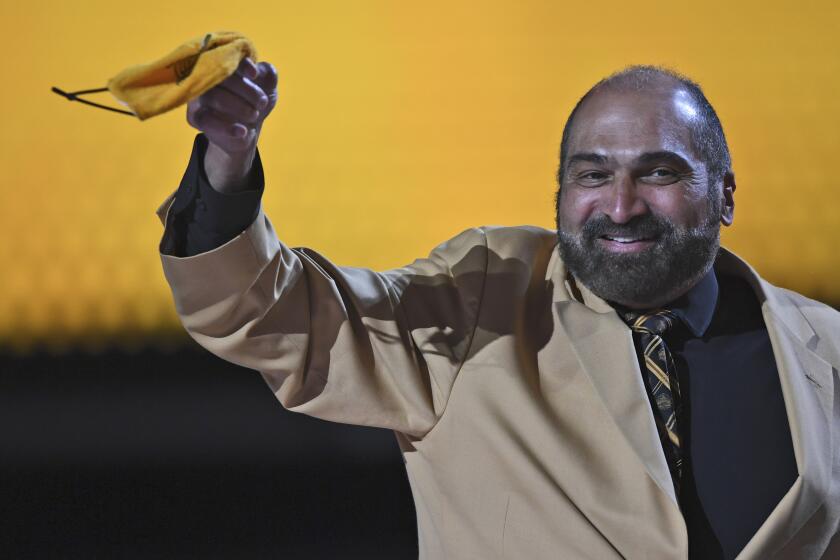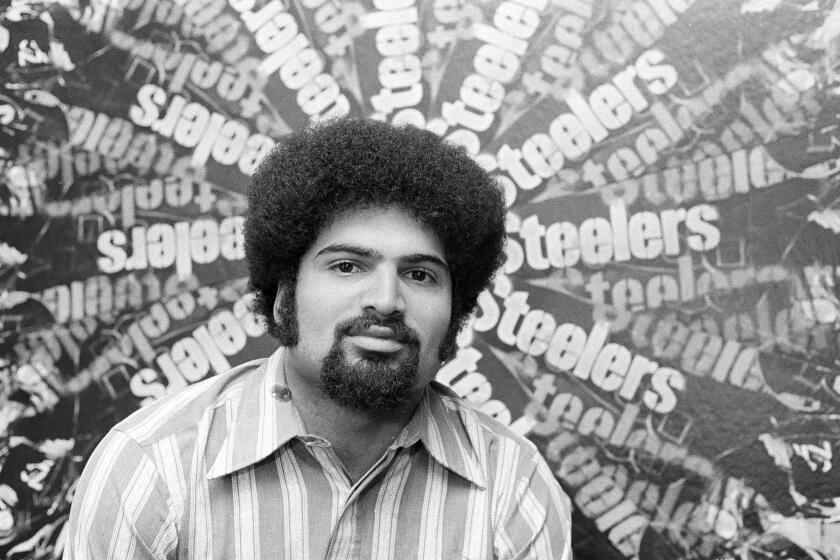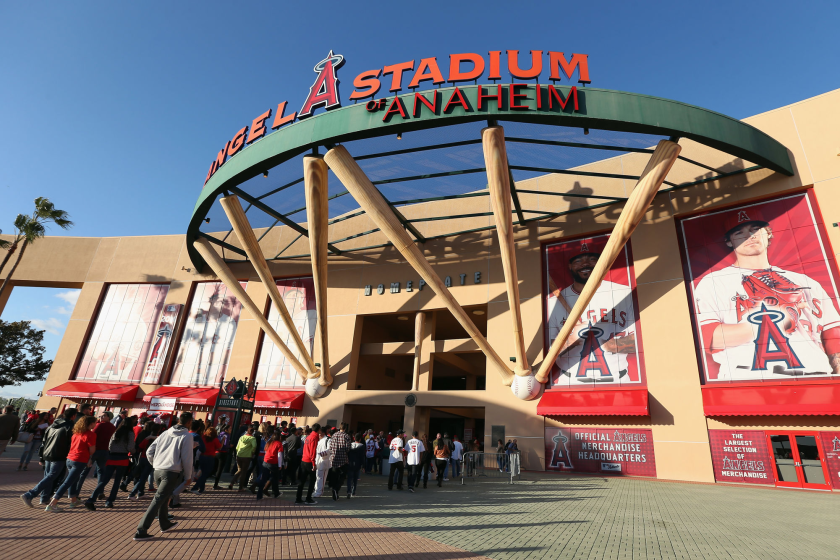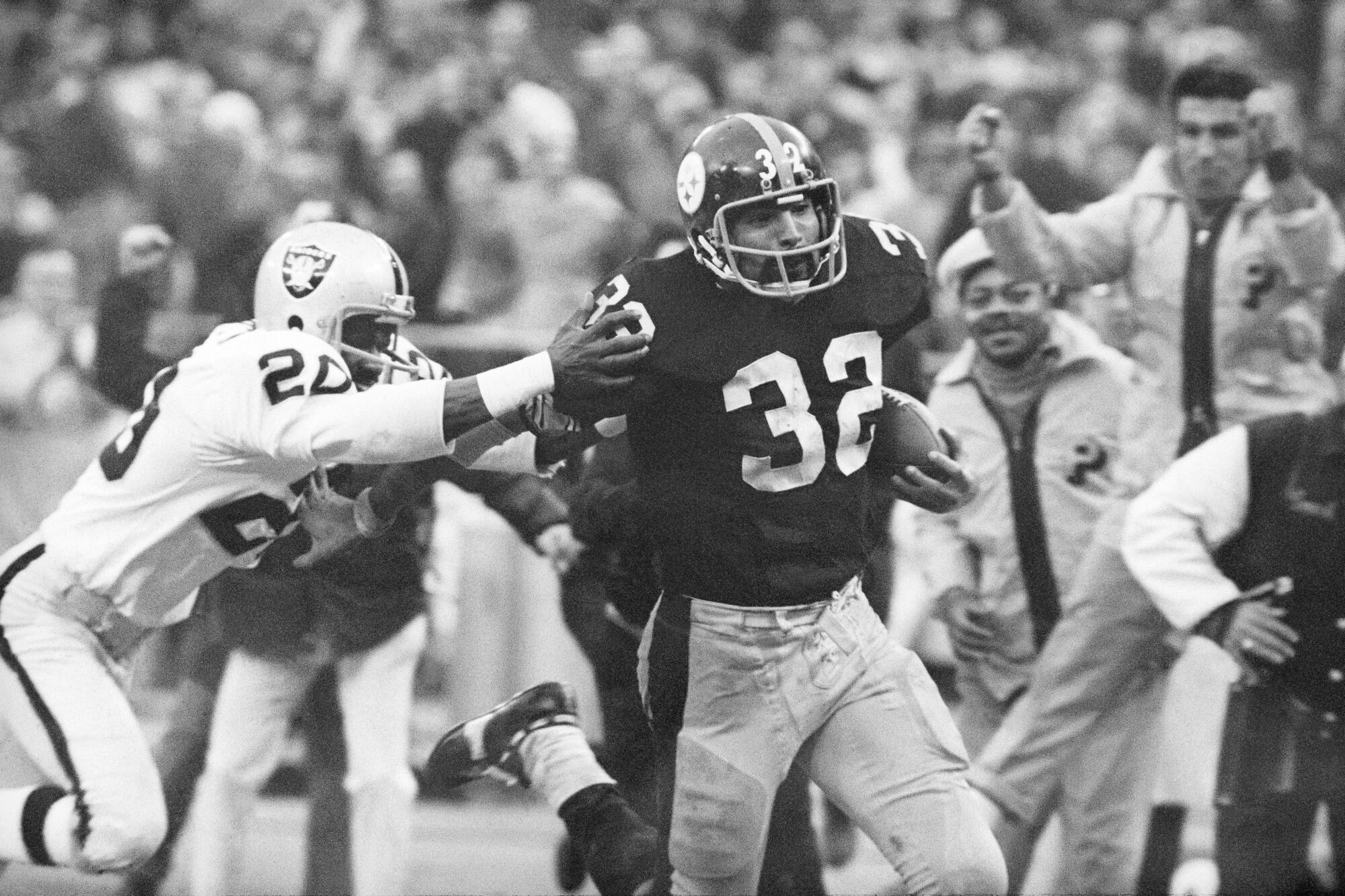
- Share via
PITTSBURGH — Moments before Franco Harris made the most improbable play in NFL history, maybe in pro sports history, his mom sensed something was wrong, even from nearly 300 miles away.
The Pittsburgh Steelers’ 1972 season was on the brink, and Harris, their star rookie running back, knew he was probably lining up for his final play that year. In an AFC divisional playoff game Dec. 23 — only the franchise’s second postseason game — the Steelers trailed the Oakland Raiders 7-6 with 22 seconds left and faced fourth and 10 at Pittsburgh’s 40-yard line.
“At home in Jersey, my brothers and sisters and my dad are watching the game,” Harris — whose death at age 72 was announced by his son Wednesday — said in an interview with The Times last month. “My mom, being from Italy, didn’t know much about football, so she’s in the kitchen drinking coffee. She could feel that something wasn’t right, though, so she went and got her Italian album out and put it on.
“My brothers and sisters swear that when the Immaculate Reception happened, ‘Ave Maria’ was playing.”
The play the Steelers ran 50 years ago Friday, 66 Circle Option, turned out to be a “Hail Mary” indeed.
Harris’ lightning-fast thinking led to the ‘Immaculate Reception,’ considered the most iconic play in NFL history, against the Raiders in 1972.
Their third-year quarterback, Terry Bradshaw, faced heavy pressure from the Raiders’ defense. He was able to fire the ball to Oakland’s 35-yard line — he has said that he saw a black Steelers jersey and simply threw to it — and a violent collision occurred between fearsome Oakland safety Jack Tatum and Pittsburgh running back John “Frenchy” Fuqua.
As Fuqua crashed to the Three Rivers Stadium artificial turf and some Raiders celebrated, believing the pass was incomplete, the ball ricocheted back toward midfield. Harris was being covered by second-year linebacker Phil Villapiano, a future four-time Pro Bowl selection and a mainstay of the Raiders’ defense in the ’70s. Seeing the ball in the air, Villapiano instinctively headed toward it.
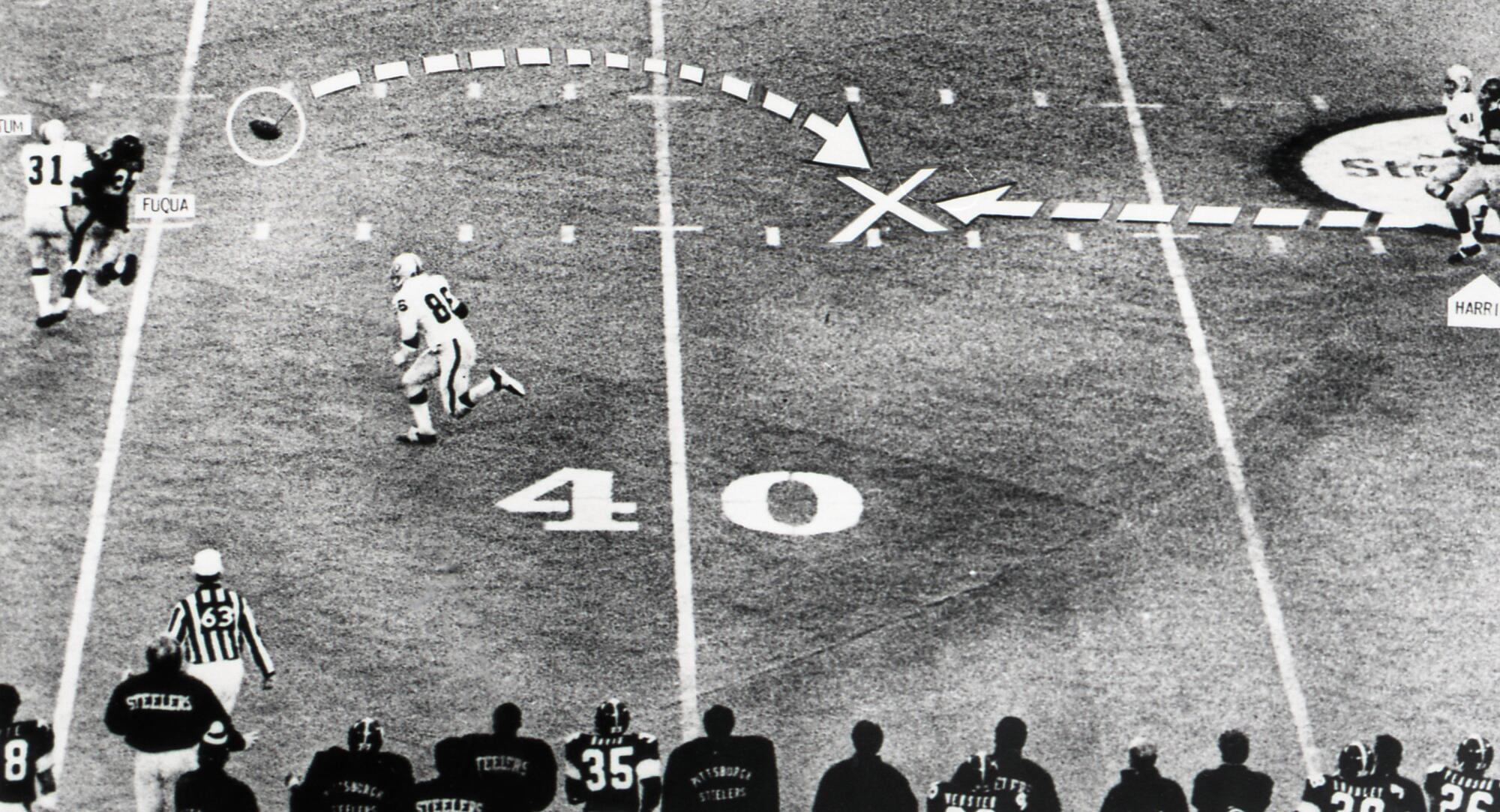
“It blows my mind that I have no visual recollection of catching the ball.”
— Franco Harris, on his “Immaculate Reception”
“What I should have done was grab Franco and pull him in tight, so it looked to the ref like he was blocking me,” Villapiano said. “But instead I see the ball bounce up in the air and then the next thing I know, Franco is running down the field. I thought to myself, ‘What the hell is he doing that for?’ ”
Harris also had run toward the ball, which he grabbed just before it hit the turf. Without breaking stride, he headed for the Steelers’ sideline, the left side of the field.
“When Bradshaw threw the ball, my first thought was to go toward the ball, because you never know what’s going to happen,” Harris said. “So I started to go to the ball and the next thing I remember was stiff-arming Jimmy Warren along the sideline.
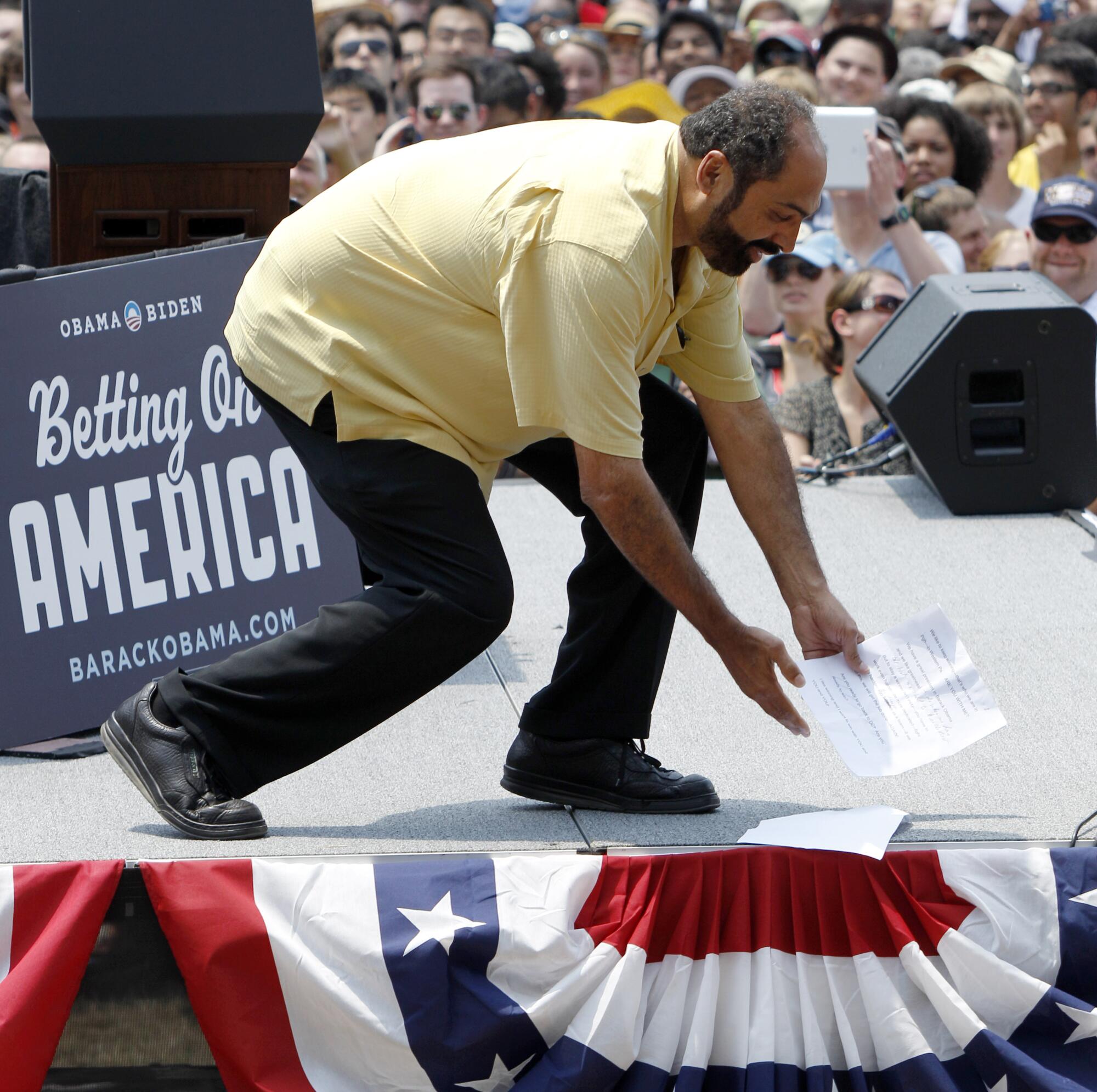
“It blows my mind that I have no visual recollection of catching the ball. That wasn’t an easy ball to catch. It just doesn’t make any sense. How did I track it? How did I keep in stride? You normally don’t catch a ball in that way. If I had dived for it, I would have been ruled down because the rules were different back then.”
In the stadium’s upper deck, 16-year-old Mike Bodura was watching the game with his father, a steelworker. The Steelers were moving away from them, which meant that the football had rocketed back in their direction after Tatum’s punishing hit on Fuqua.
“You saw that collision in the middle of the field, and people around us slumped in their seats because we all figured the pass was incomplete,” said Bodura, a lifelong Pittsburgher. “And then some guy near us yelled, ‘Hey, Franco’s got the ball!’ and we saw him running down the left sideline.”
Harris encountered Warren, the Raiders’ veteran cornerback, around the 10-yard line but managed to fend him off and run into the end zone, setting off pandemonium. Harris’ teammates mobbed him, and fans poured out of the stands. Five seconds remained on the game clock.
Franco Harris is best known for the Immaculate Reception and other big plays, but many Steeler fans will remember him for his generosity off the field.
Art Rooney II, now owner and president of the Steelers, was 20 at the time and worked as an assistant equipment manager for the team that season. The play had unfolded right in front of him.
“There were a lot of people on the field, and one of the things I remember most,” Rooney said, “is that one of our former players from the ’60s, Brady Keys, ran onto the field and gave me a bear hug so hard that I almost passed out.”
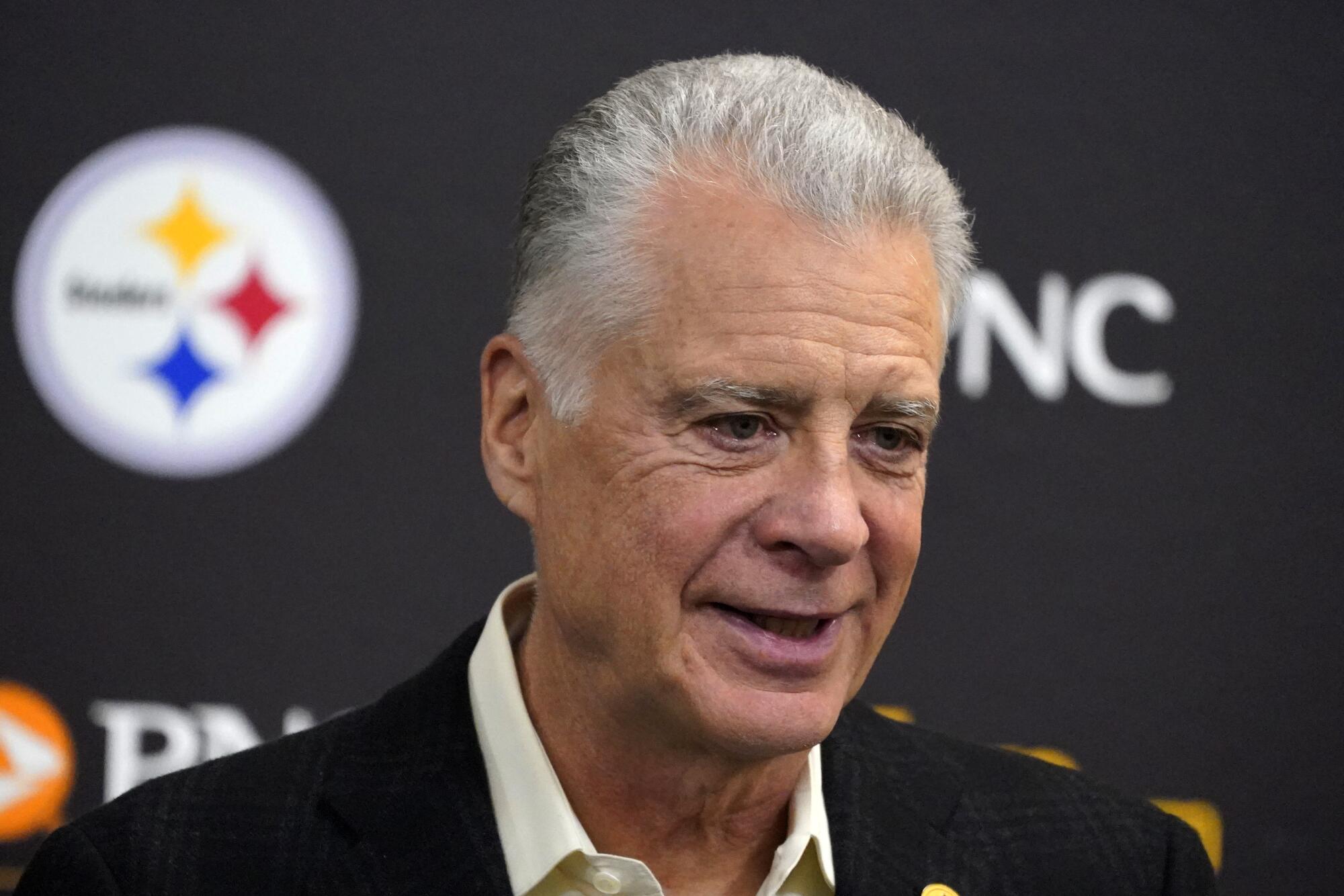
But should Harris’ touchdown count? At the time, NFL rules stated that an offensive player was ineligible to catch the ball if it had caromed off one of his teammates without a defensive player also touching it. Had the ball bounced off Tatum, or had it struck Fuqua? Or had both touched it?
“I don’t think that any of us players knew the rule about two offensive players touching the ball, but the one guy who did was John Madden,” Villapiano said, referring to the Hall of Fame coach of the Raiders. “He was storming onto the field and trying to tell the officials about it.”
The officials huddled to try to sort out what had happened, as the entire stadium waited for a verdict. “There were no replays on the scoreboard in those days, so you couldn’t see the play again,” Bodura points out.
Eventually someone called the press box and Steelers public relations director Joe Gordon answered.
“There was a phone in the dugout … and our stadium operations manager called me directly and said, ‘[Referee Fred] Swearingen wants to talk to [Art] McNally.’ He was the NFL supervisor of officials, who happened to be at the game,” said Gordon, who handled PR for the Steelers from 1969 to 1998.
“So I handed the phone to McNally and I heard him say, ‘What did you see?’ He listened for a bit and then said, ‘Well, call it then.’ The whole conversation lasted 10 to 15 seconds.”
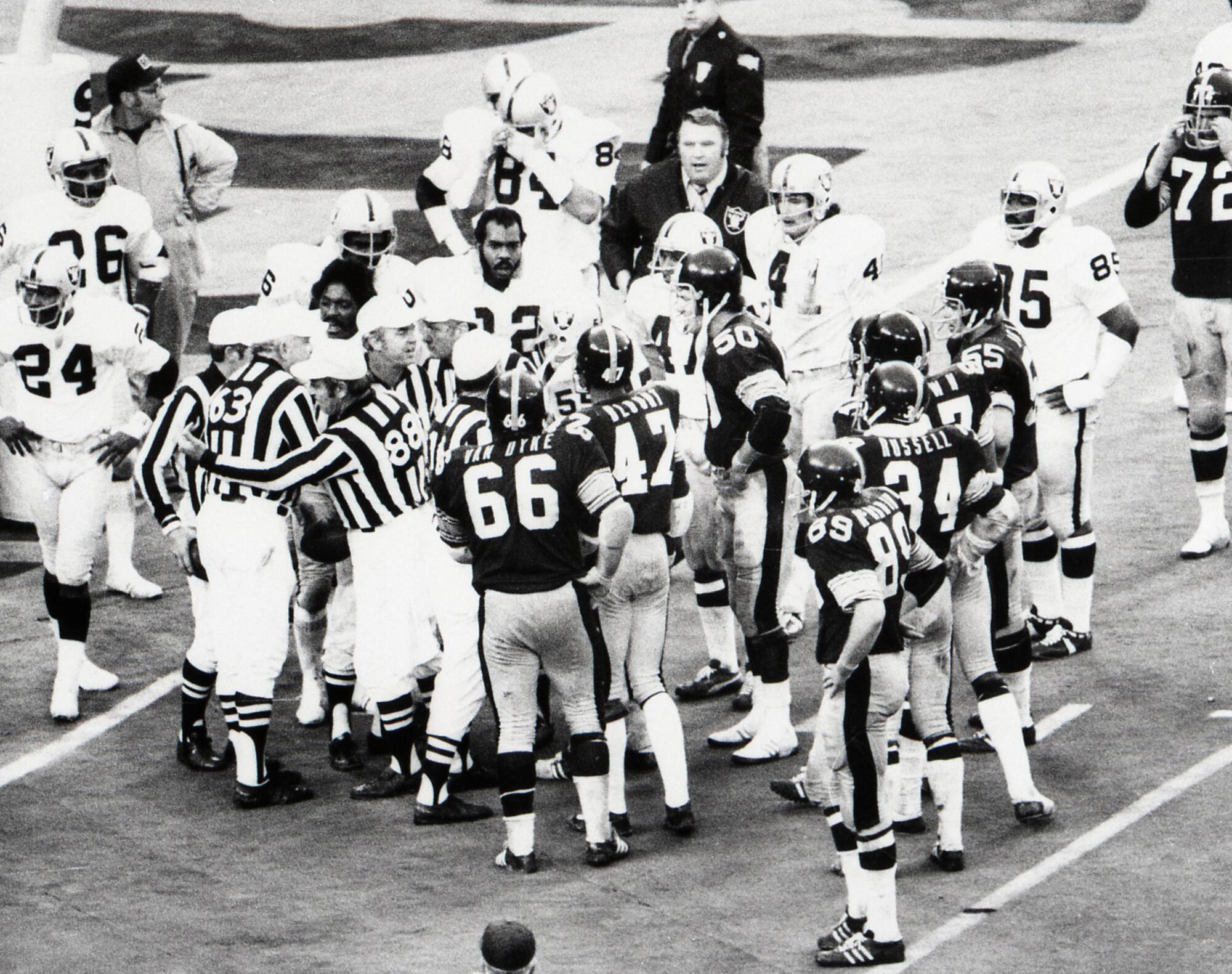
“It was getting scary on the field. All it would have taken was for one person to throw a punch and things could have gotten really bad. Those Steelers fans were crazy.”
— Phil Villapiano, former Raiders linebacker, on the field conditions after the “Immaculate Reception”
When the touchdown was confirmed, bedlam resumed. The Steelers kicked the extra point to make the final score 13-7, then fought their way through ecstatic fans to their locker room. The Raiders were left angry, confused and bitterly disappointed.
Villapiano, who remains firm in his belief that the football struck only Fuqua and that Harris’ touchdown should not have counted, chalks up the officials’ ruling to home-field advantage.
“That’s just the way it is,” Villapiano said. “It was getting scary on the field. All it would have taken was for one person to throw a punch and things could have gotten really bad. Those Steelers fans were crazy. I think they were just as bad as the fans in Philadelphia.”
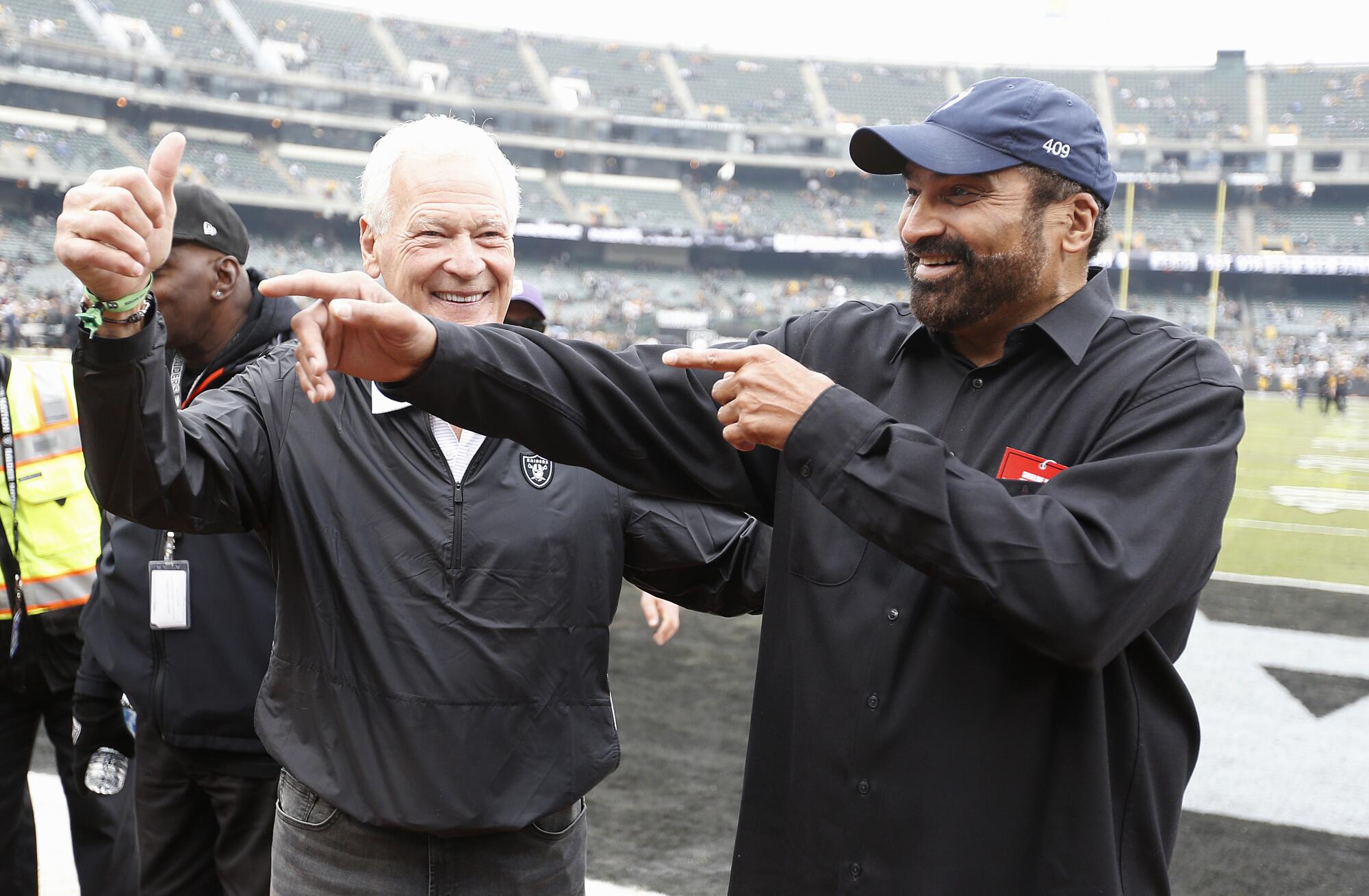
In another odd twist that day, Rooney’s grandfather, Art Sr., the Steelers’ founder and then-owner, didn’t get to see the play that gave his team its first playoff victory after 40 years of futility.
Art Rooney Sr. made it a habit to greet the players in the locker room when they came off the field, win or lose, so he was on an elevator when Harris scored. When he stepped off the elevator, he heard the roar of the crowd and asked a security guard what happened, Gordon said. The man replied, “You won!”
After celebrating with his teammates in the locker room, Harris didn’t go out on the town to bask in the victory. The 22-year-old had plans to visit his family for Christmas.
“I actually went to the airport right from the stadium,” Harris said. “I went to grab a sandwich before my flight, and I walked in and the whole Raiders team was sitting there. It was a little awkward.
“I guess they were waiting for their charter, but I felt a chill go through the air. I was the last person they wanted to see. Only one of the players, Mike Siani, who I knew from a college all-star game, came up to say hello. Nobody else said anything to me.”
That evening, Michael Ord, a reveler at a Pittsburgh bar, stood up and offered a toast to what he called the “Feast of the Immaculate Reception.”
His girlfriend at the time, Sharon Levosky, liked the name so much that she called one of the local TV stations and asked to speak to colorful sportscaster Myron Cope, a Pittsburgh institution.
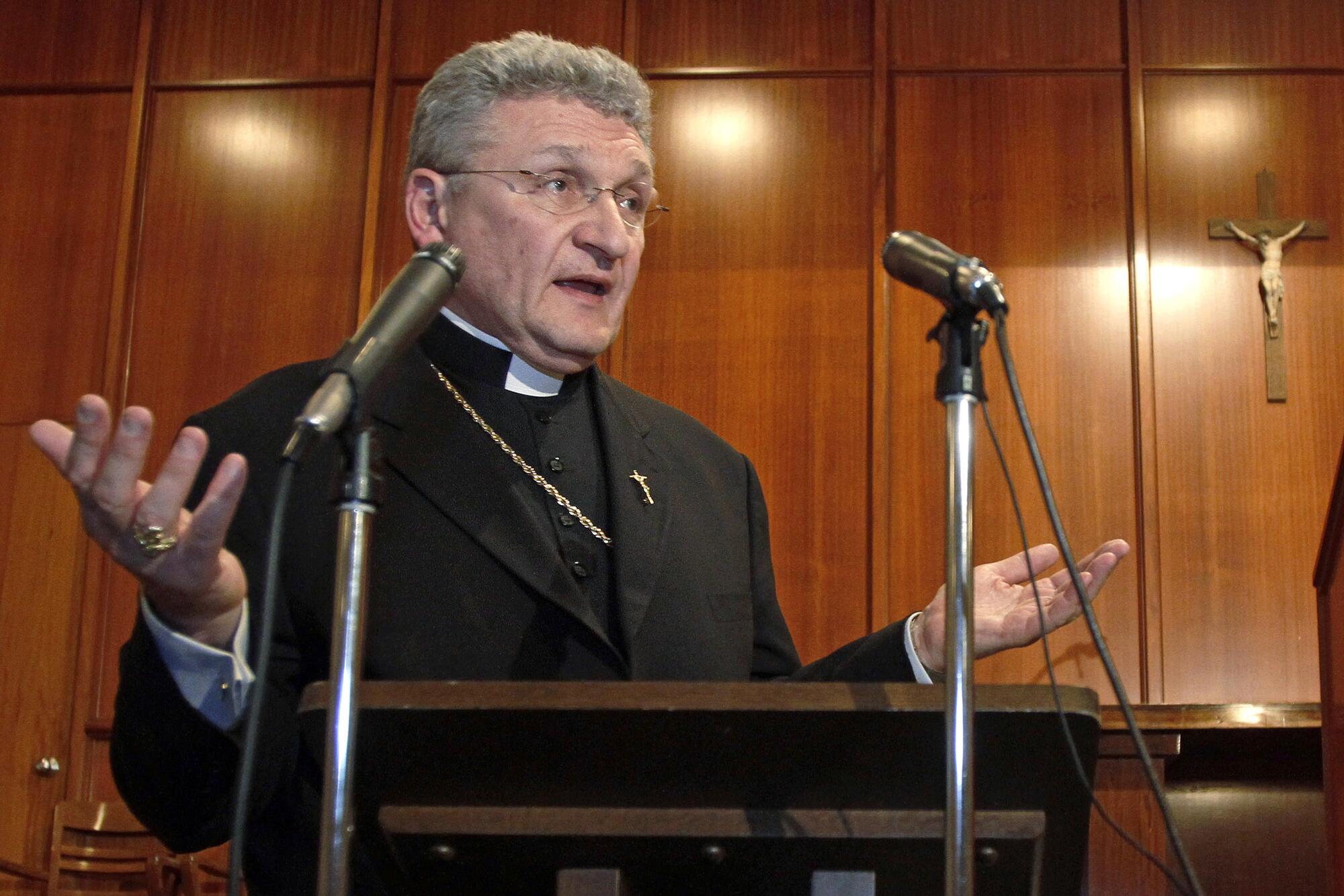
“As a lifelong Steelers fan, I have always found spiritual meaning in the term ‘Immaculate Reception.’ ”
— Bishop David Zubik, on the nickname for the famous catch by Franco Harris in 1972
Cope, who later created the Steelers’ ubiquitous Terrible Towel, was still at Three Rivers Stadium, Gordon said, and Levosky’s call was patched through to him in the Steelers’ equipment room.
Cope loved the name Ord had come up with but wondered whether it might offend religious viewers, Gordon said. He needn’t have worried, apparently.
“As a lifelong Steelers fan, I have always found spiritual meaning in the term ‘Immaculate Reception,’ ” said Bishop David Zubik of the Diocese of Pittsburgh, who was a seminarian visiting his parents for Christmas that day. “The play especially made people aware of a spiritual dimension that exceeded a football game.”
Cope did in fact use “Immaculate Reception” on his newscast, and the rest is history. Football fans have now seen the play countless times, and the NFL Network ranked it No. 1 on its list of the 100 greatest plays in league history. A statue depicting Harris catching the football greets travelers at Pittsburgh International Airport (along with figures of George Washington and pioneering journalist Nellie Bly).
And the play sparks debates to this day about who touched the football, Fuqua or Tatum.
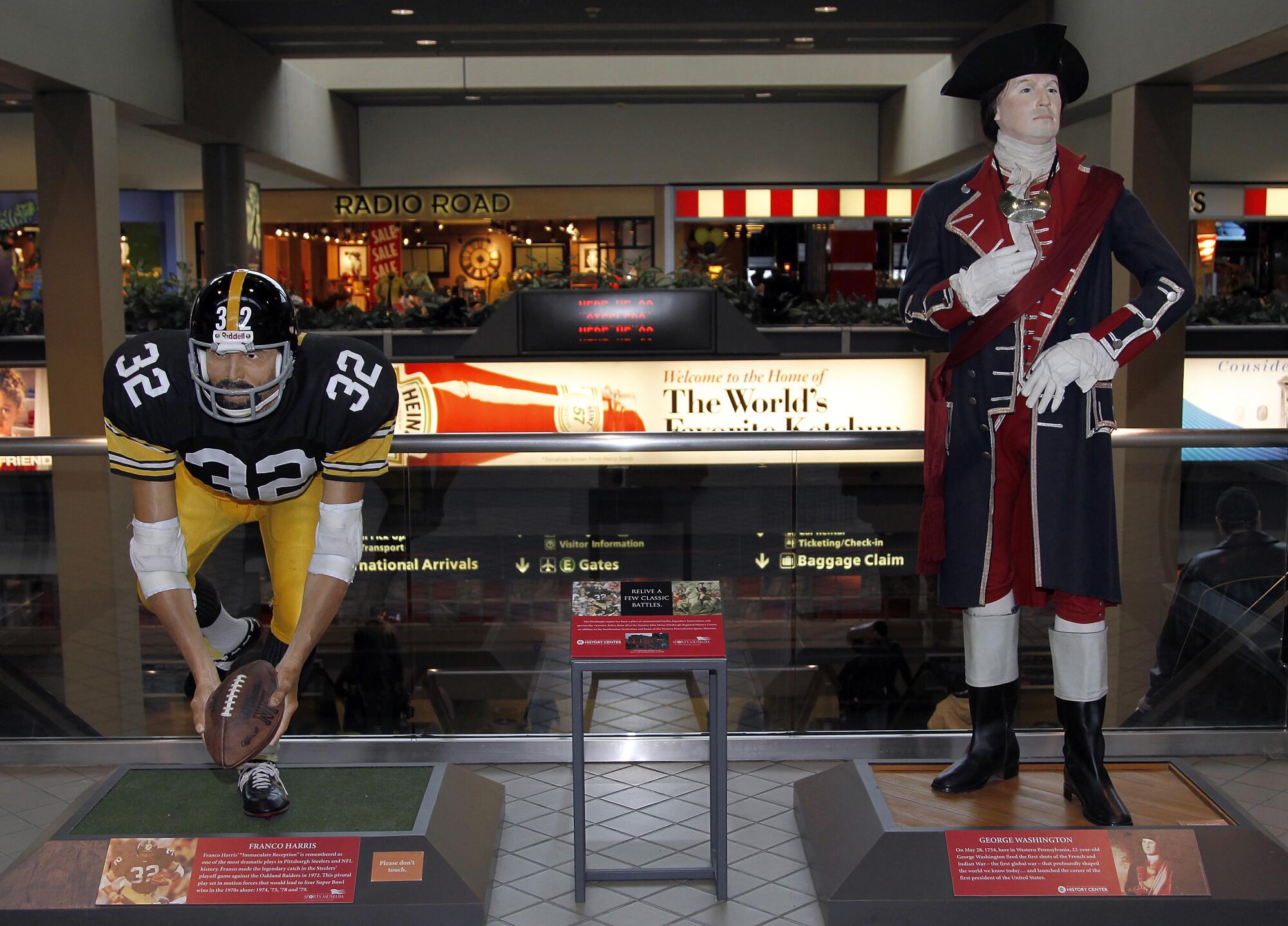
Fuqua, a flashy dresser who wore platform shoes with see-through heels that had tropical fish swimming in them, always has refused to say who touched the ball. Tatum, who died in 2010 and was infamous for his crushing hits on receivers, always maintained that the ball ricocheted off Fuqua and should have been ruled dead when Harris caught it.
“I talked with Jack Tatum about the play a number of times, and his passion about it never dimmed,” said Amy Trask, who was the Raiders’ chief executive from 1997 to 2013. “He was unequivocal in his view of what happened.”
Villapiano says it’s only logical that the football struck Fuqua, not Tatum.
“I saw ‘Tates’ drill Fuqua in the back, so how could the ball have bounced off Jack?” he said.
Although the Steelers lost the AFC championship game the week after the Immaculate Reception to the undefeated Miami Dolphins, 21-17, the victory over the Raiders marked a turning point.
Pittsburgh would go on to win four Super Bowls in six seasons and claim the unofficial title of the NFL team of the ’70s. That gave the city a much-needed lift, Art Rooney II said.
“That game and the success we had after that was something the city could really take pride in,” he said. “It was a tough time here in the ’70s with the steel industry dying, but the Steelers gave people something to hang on to during those tough times.”
The Raiders, for their part, continued to dominate the AFC West and eventually won Super Bowl titles in the 1976, 1980 and 1983 seasons. They faced the Steelers in the postseason five seasons in a row, from 1972 to 1976; in the final three seasons, the winner of their matchup went on to win the Super Bowl.
“For a concentrated period of time, I think that was the most intense rivalry that pro football and sports in general has ever seen,” said author Ed Gruver, who co-wrote a book about the teams’ rivalry, “Hell with the Lid Off.”
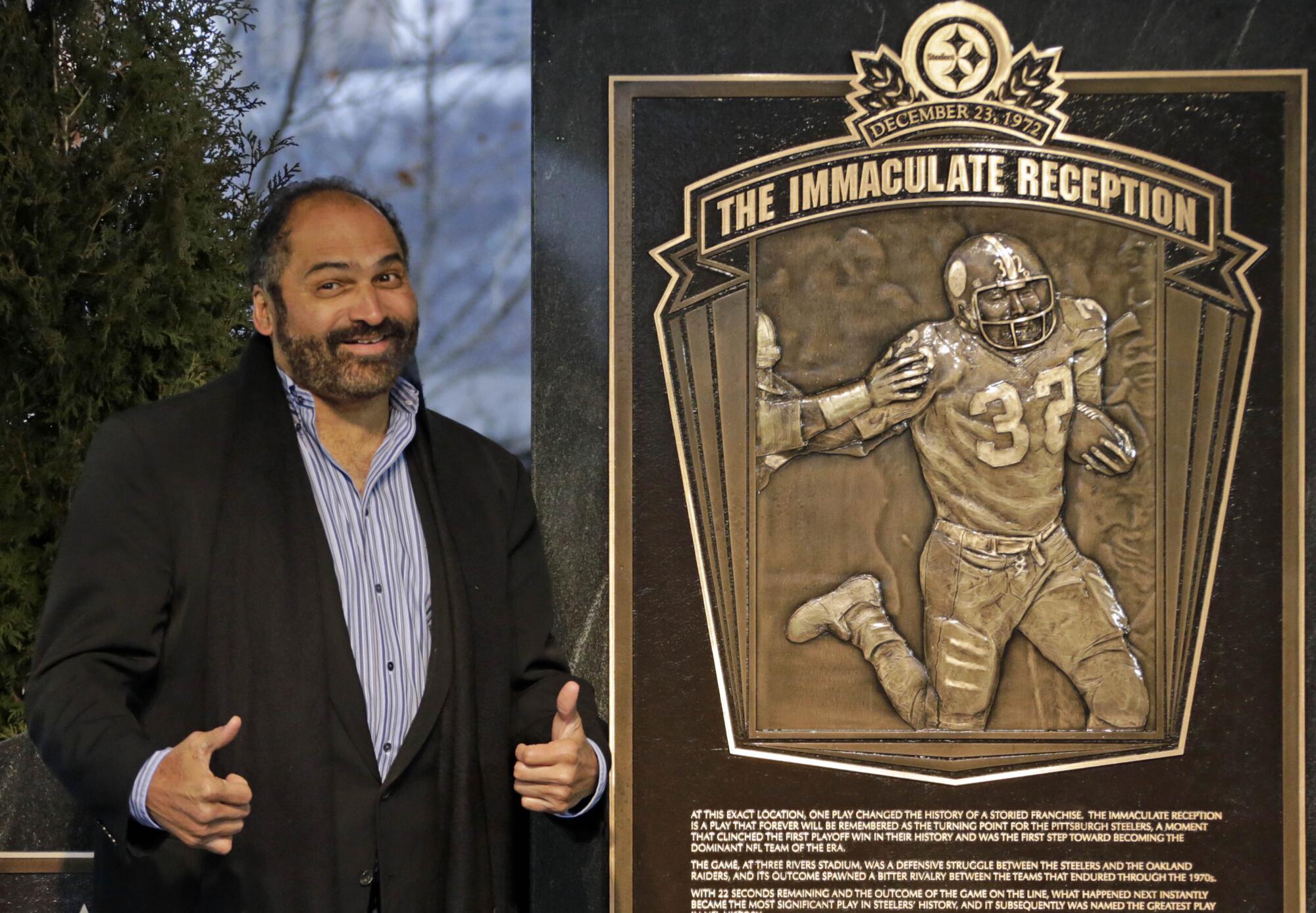
The 50th anniversary of the Immaculate Reception will be a big deal in Pittsburgh. Among the scheduled events is a ceremony Friday at the exact spot where Harris caught the ball in long-demolished Three Rivers Stadium (a marker there commemorates the play). On Christmas Eve, the Steelers will host the Raiders, who now play in Las Vegas, with Harris’ jersey No. 32 being retired at halftime.
Harris, who was inducted into the Pro Football Hall of Fame in 1990 and rushed for more than 12,000 yards during his career, would chuckle sometimes when watching himself catch the football in replays from that day in 1972.
“I wasn’t running very fast,” he said, “but I guess it was the right speed at the right time. And in the right place.”
Although Villapiano’s team lost the game and he believes the officials made the wrong decision, he doesn’t tire of talking about the play.
“It’s one of the craziest things, and nobody knows the answers,” he said. “That’s why people are still so interested in it and why it keeps getting more and more immaculate.”
More to Read
Go beyond the scoreboard
Get the latest on L.A.'s teams in the daily Sports Report newsletter.
You may occasionally receive promotional content from the Los Angeles Times.
